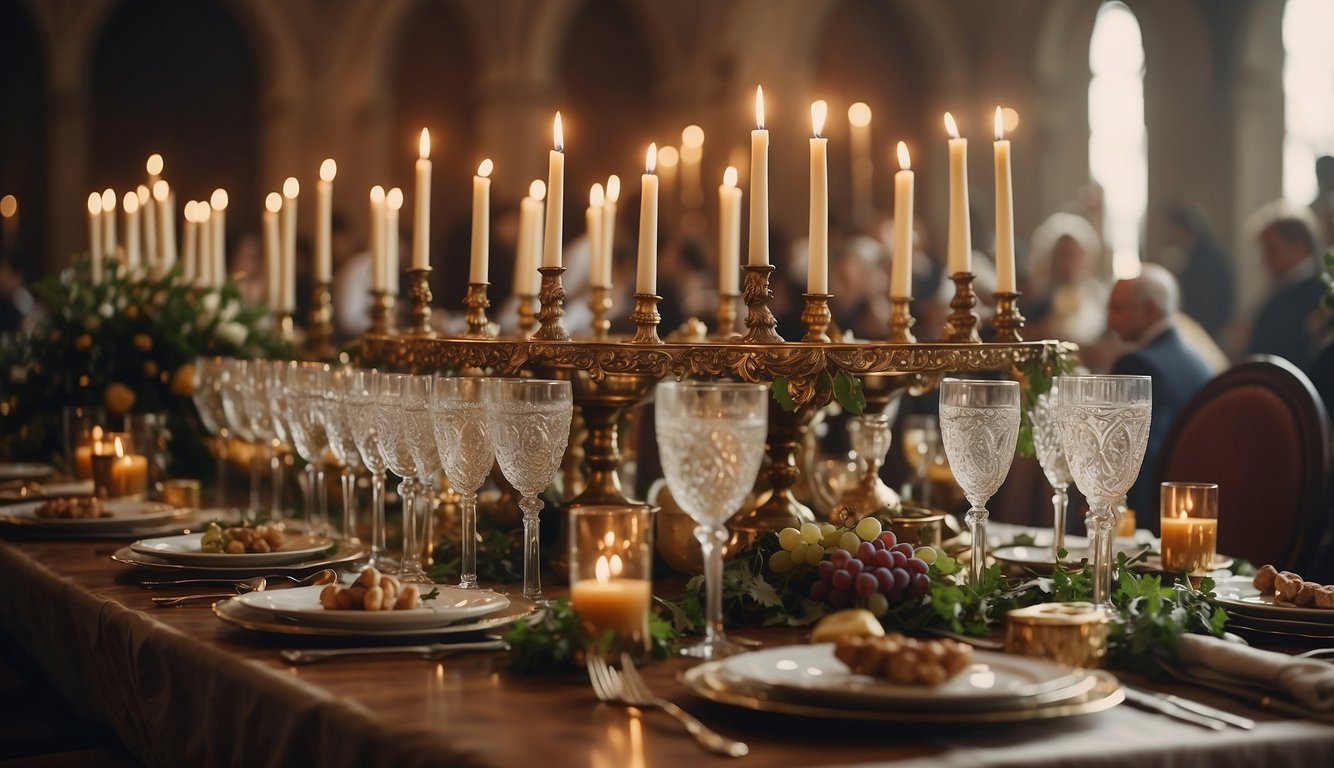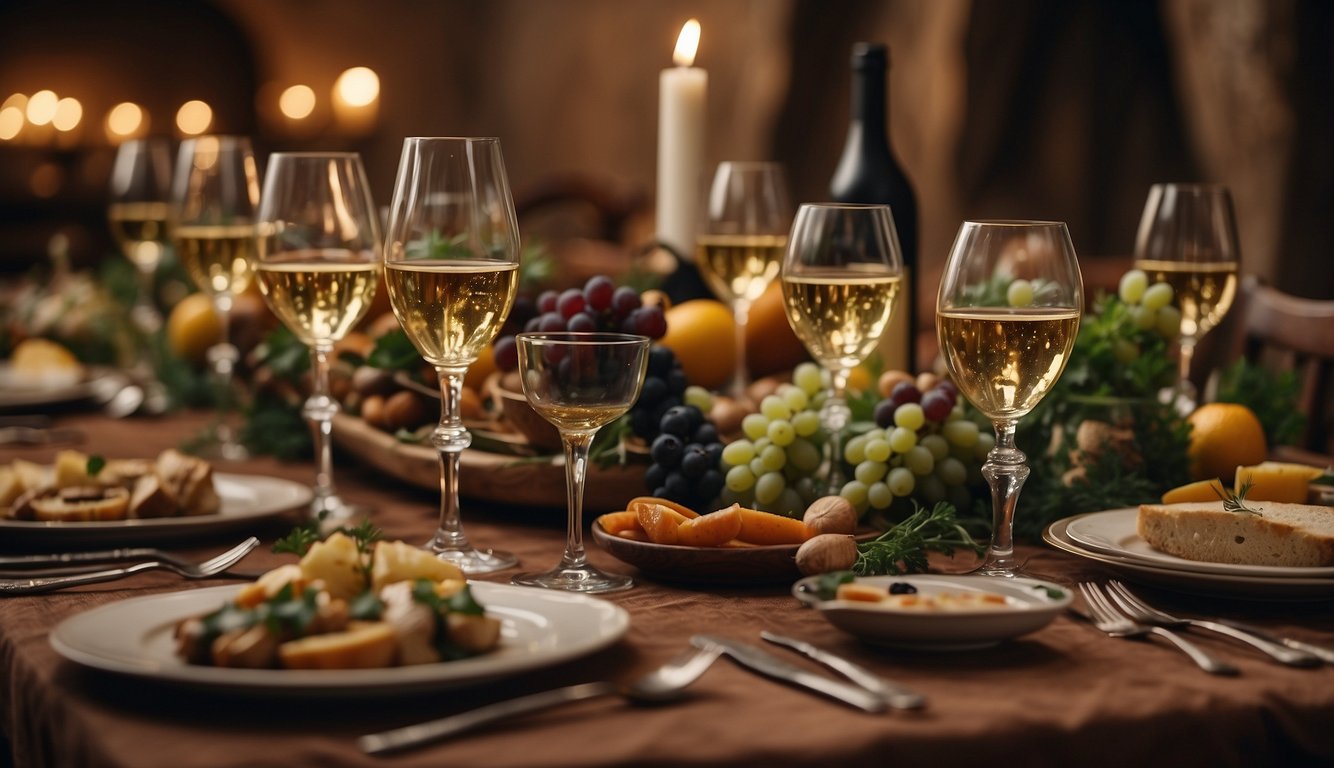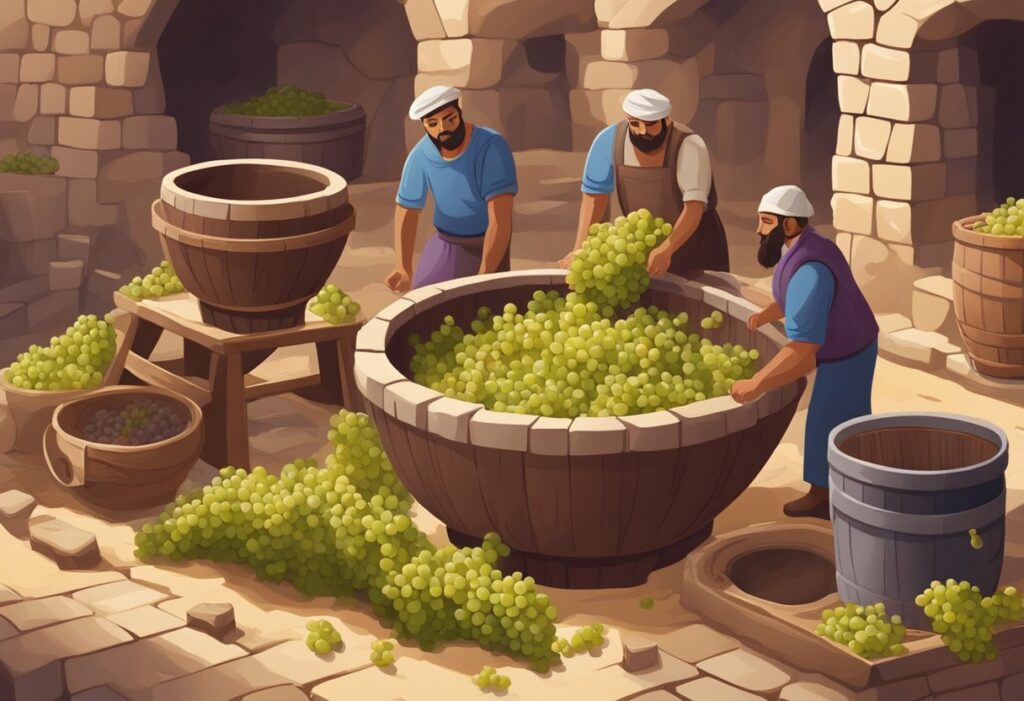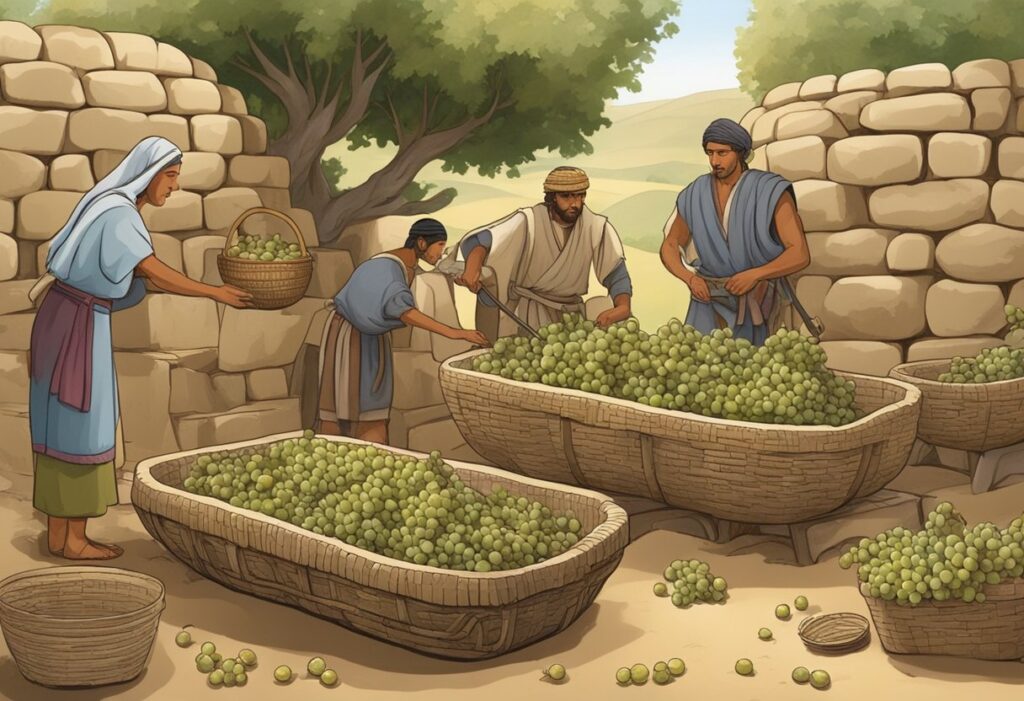Wine played a crucial role in medieval European feasts and festivals, symbolizing joy, wealth, and social status. When you picture a grand medieval feast, wine often flows freely, enhancing the celebratory atmosphere. Nobles and royalty would host these lavish events, showcasing their power and wealth with the finest wines served in ornate vessels like silver goblets and carved drinking horns.

In medieval society, wine wasn’t just a marker of luxury; it was integral to daily life and special occasions. You’ll find that feasts were incomplete without ample quantities of wine, which was believed to nourish the spirit and foster community. Monasteries and vineyards across Europe worked tirelessly to cultivate high-quality grapes, ensuring a diverse and plentiful supply of this prized beverage.
Consider how wine influenced various aspects of life, from religious ceremonies to trade and culture. Medieval pub scenes often featured people enjoying different types of wine, reflecting regional preferences and winemaking techniques. Understanding the vital role of wine in these grand events reveals much about the social and cultural fabric of medieval Europe. Dive into this fascinating topic and explore how wine shaped the celebrations and daily life of medieval people.
The Historical Roots of Wine in Medieval Europe
Wine played a crucial role in medieval European society. Its significance stretched from religious ceremonies to daily life and economic activities.
Viticulture and Winemaking Heritage
Viticulture and winemaking have deep roots in medieval Europe. Vineyards were scattered across the continent, with each region developing unique techniques. The quality and variety of wine depended on regional grape cultivation and local winemaking skills.
In the Middle Ages, monasteries were hubs of wine production. Monks meticulously maintained vineyards, refining their methods over centuries. These religious institutions were crucial in preserving and advancing winemaking knowledge, making them key players in medieval viniculture.
The spread of vineyards across Europe was heavily influenced by both noble estates and religious institutions, ensuring wine’s role in both economics and society.
The Church and Wine
The church had a profound impact on the culture of wine in medieval Europe. Religious ceremonies depended heavily on wine, particularly in rituals like the Eucharist. This sacred role ensured that the church was deeply involved in vineyard management and wine production.
Monasteries played a dual role: spiritual centers and agricultural hubs. They not only produced wine for religious purposes but also sold it, contributing significantly to local economies. This made monasteries central to the spread and improvement of winemaking practices.
The church also imposed and enforced wine laws and regulations, which shaped the cultural norms around wine consumption throughout medieval Europe.
Wine’s Role in Social Stratification
Wine was a symbol of social status in medieval Europe, reflecting one’s position in society. The quality of wine consumed could vary greatly, with nobles enjoying finer varieties while peasants often drank simpler, less refined versions.
At feasts and festivals, the type and amount of wine one could offer were direct indicators of wealth and prestige. Consequently, nobility and the wealthy class sought to demonstrate their status through lavish wine displays.
This social stratification was also evident in the control over wine production. Nobles and religious institutions owned most vineyards, dictating the quality and distribution of wine, thereby maintaining their status and influence over the populace.
These intertwined roles of wine, from religious significance to social stratification, highlight its deep-rooted importance in medieval European life.
Cultivation and Production Techniques
In the Middle Ages, winemaking was a detailed process requiring expert knowledge of vineyards and fermentation methods. This process ensured that each bottle of medieval wine met the standards needed for feasts and festivals.
The Lifecycle of Vineyards
The cultivation of vineyards was crucial to producing high-quality wine. Grapevines were planted in regions with the best soil and climate. Farmers used trellises or stakes to support the growing vines.
The lifecycle of a vineyard involved careful management. Pruning was vital to ensure the vine focused its energy on fewer grapes. This practice increased the concentration of flavors. Regular maintenance, such as removing pests and weeds, kept the plants healthy.
From spring to fall, vineyard workers monitored the vines. They aimed for the best time to harvest, usually late summer or early fall, when the grapes were at perfect ripeness.
From Harvesting to Fermentation
Harvesting was done by hand, ensuring that only the best grapes were selected. Once picked, the grapes were crushed to extract the juice. In medieval times, this was often done by stomping on the grapes in large tubs. The juice was then collected for the next stage.
Fermentation was key to turning grape juice into wine. This process involved yeast converting the sugars in the juice into alcohol and carbon dioxide. Winemakers monitored the fermentation process closely, adjusting conditions such as temperature to influence the final taste.
Fermentation could take a few days to several weeks, depending on the desired wine style. After fermentation, the young wine was transferred to barrels for aging.
Storage and Craftsmanship of Wooden Barrels
Proper storage was essential for the wine’s development. Wooden barrels were commonly used for aging and storage. The craftsmanship involved in making these barrels was highly regarded.
Coopers (barrel makers) selected the finest oak wood for their barrels. The wood was seasoned and shaped into staves. Each stave was fitted together, secured with metal hoops, and finally, sealed to prevent leaks. The barrels influenced the wine’s flavor, adding notes of vanilla, spice, and sometimes smokiness.
Storing wine in barrels allowed it to mature, developing more complex flavors. The final product was a testament to the skill and dedication of the winemakers and coopers alike.
The Significance of Wine in Feasts and Banquets

Wine played a vital role in medieval European feasts and banquets, serving not only as a drink but also as a symbol of wealth, religious devotion, and social status.
Grand Feasts and Royal Courts
During grand feasts in the royal court, wine was a key element. Nobles would gather to enjoy elaborate meals, with wine being the highlight of the event. These gatherings were not just about drinking but also about showcasing power and wealth. A rich display of fine wines demonstrated the host’s opulence and generosity. This was crucial for maintaining social hierarchy and winning political favor.
Lavish feasts often featured multiple courses paired with different wines, enhancing the dining experience. Notably, these events were chances for nobles to strengthen alliances and negotiate. The presence of high-quality wines at these feasts was essential for displaying the host’s affluent status.
Wine as a Symbol in Religious Ceremonies
Wine also held deep significance in religious rites and Christian rituals. In medieval times, religious ceremonies such as the Eucharist used wine to symbolize the blood of Christ. This made wine sacred, emphasizing its importance beyond mere consumption.
Churches and monasteries often produced their own wine, underscoring its importance in religious contexts. Wine was essential in various ceremonies, marking important events and celebrations. Religious feasts incorporating wine were pivotal in bringing the community together, highlighting both devotion and tradition.
The Social Fabric of Festivals
Wine deeply influenced the social aspect of festivals. During these events, it was common for people to gather and share wine, fostering a sense of community. Festivals often featured public feasts where wine was freely poured, creating an inclusive atmosphere.
Wine consumption at these festivals was not just for leisure. It served to bond people and reinforce social ties. People of all classes would partake in these festivities, making wine a bridge across social divides. These gatherings helped cultivate a shared cultural identity, enhanced by the collective enjoyment of wine.
Feel free to explore more about the importance of wine in medieval culture and how it was intertwined with various aspects of life, from royal courts to religious ceremonies, to deeply rooted social traditions.
Trade and Economics of Medieval Wine

Wine played a significant role in medieval Europe’s economy. Both monastic communities and trade routes were crucial in the widespread distribution and cultural integration of wine.
Monastic Influence on Trade
Monastic communities had a significant impact on the medieval wine trade. Monks were among the primary wine producers, as many monasteries had their own vineyards. They invested in advanced winemaking techniques, improving the quality and storage of wine.
Monasteries often served as commercial hubs. Monks traded wine with local peasants and nobles, facilitating economic interactions. The revenue generated from wine sales supported the monasteries’ operations and charitable activities.
Monks also maintained extensive trade networks. This helped distribute wine over long distances, enhancing its economic significance. By setting production standards and maintaining quality, monasteries ensured a consistent supply, stabilizing the wine market.
Trade Routes and the Spread of Wine Culture
Trade routes were vital in spreading wine culture across Europe. Coastal and river routes allowed merchants to transport wine efficiently. Key trade routes included the Rhine and Danube rivers, connecting various regions and fostering economic exchange.
Wine became a staple commodity, traded alongside other goods. Merchants utilized these routes to reach distant markets, increasing the availability of wine. This boosted the economy, as wine trade generated substantial revenue from taxes and tariffs.
The spread of wine culture influenced social structures. Nobles and peasants alike consumed wine, bridging social gaps. As wine became more accessible, it played a central role in feasts and festivals.
These trade networks also facilitated the exchange of viticulture knowledge. As techniques and practices spread, wine production improved, further enhancing its economic impact.
Regional Variations and Famous Grape Varieties

Different regions in medieval Europe cultivated unique grape varieties, leading to a diverse world of wines. Each area had its own specialties, influenced by local climates and soil types.
France: Bordeaux and Beyond
France, known for its rich viniculture, had regions like Bordeaux producing renowned wines. Bordeaux’s fertile soils and favorable climate allowed for the cultivation of Cabernet Sauvignon and Merlot grapes. These varieties produced deep, robust red wines, which were favorites at medieval feasts.
Beyond Bordeaux, areas like Burgundy focused on Pinot Noir and Chardonnay. These grapes thrived in the cooler climate, creating balanced and complex wines. Viniculture techniques from Bordeaux and Burgundy set standards that influenced wine-making across Europe.
The Riesling of Germany and White Wines of Italy
Germany’s contribution to medieval wine culture included the famous Riesling grape. Grown predominantly in the Rhine region, Riesling was prized for its versatility and distinct taste. This white grape produced wines that ranged from dry to sweet, fitting various tastes and occasions.
In Italy, regions like Tuscany and Emilia-Romagna excelled in cultivating white grape varieties. The Verdicchio and Trebbiano grapes were popular, producing crisp and refreshing wines. These Italian whites complemented the diverse medieval cuisine and were essential in local and foreign trade, emphasizing the importance of wine in daily life.
The Iberian Traditions: Spain and Portugal
Spain and Portugal brought unique flavors to medieval wine culture. In Spain, the Tempranillo grape was known for its rich, full-bodied red wines, often aged for years to develop complexity. The region of Rioja became famous for its advanced wine-making techniques and quality.
Portugal, with its Port wine, used grapes like Touriga Nacional. This fortified wine was sweet, strong, and enjoyed at festivals and celebrations. Portuguese viniculture also included light, fragrant wines from regions like Vinho Verde, showcasing the diversity of their production.
By focusing on these regional variations, you can appreciate how medieval European wine culture embraced various grape varieties, climates, and traditions, enriching the feasts and festivals of the time.

